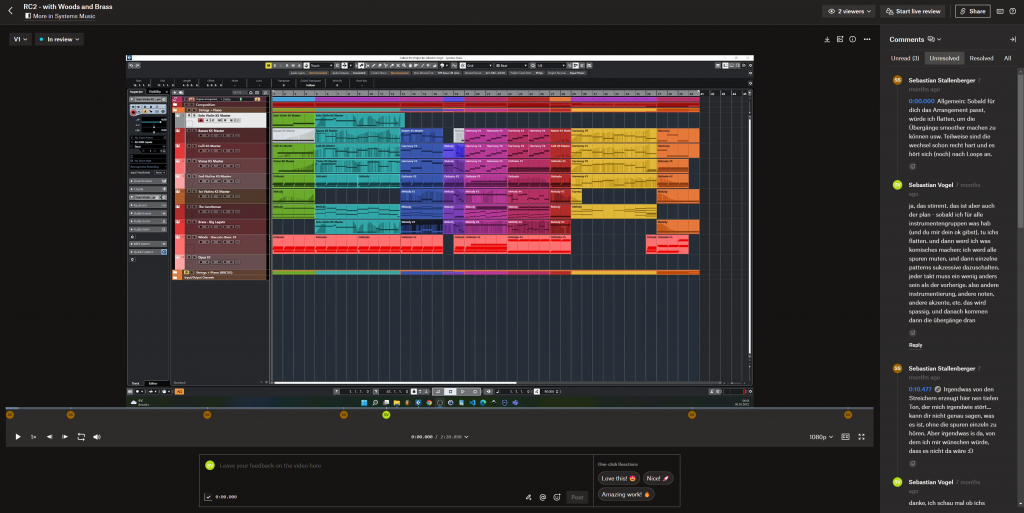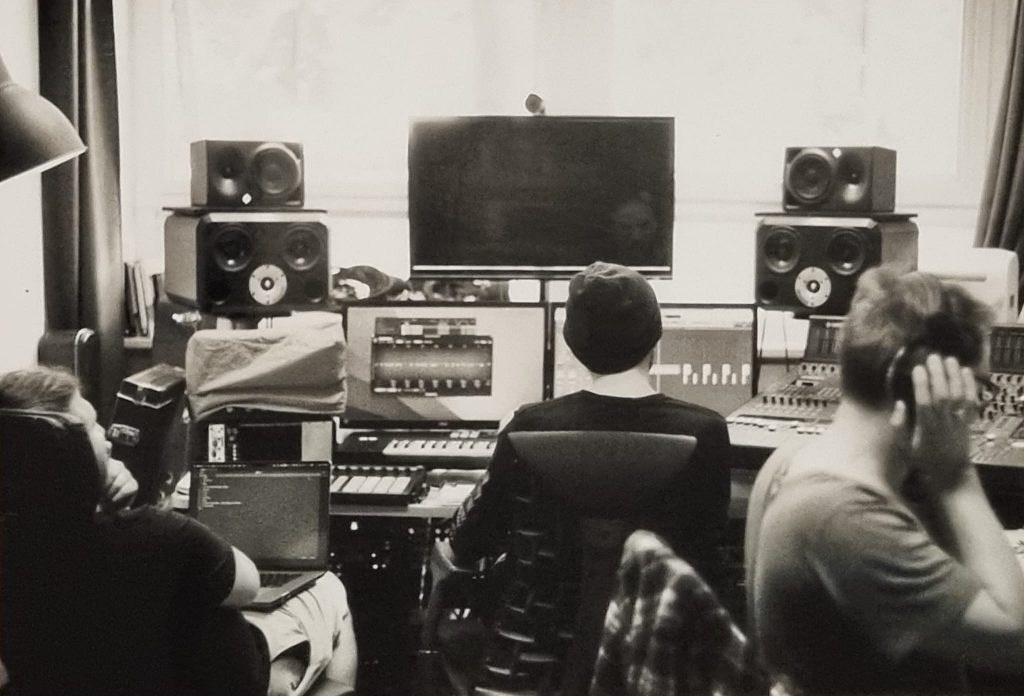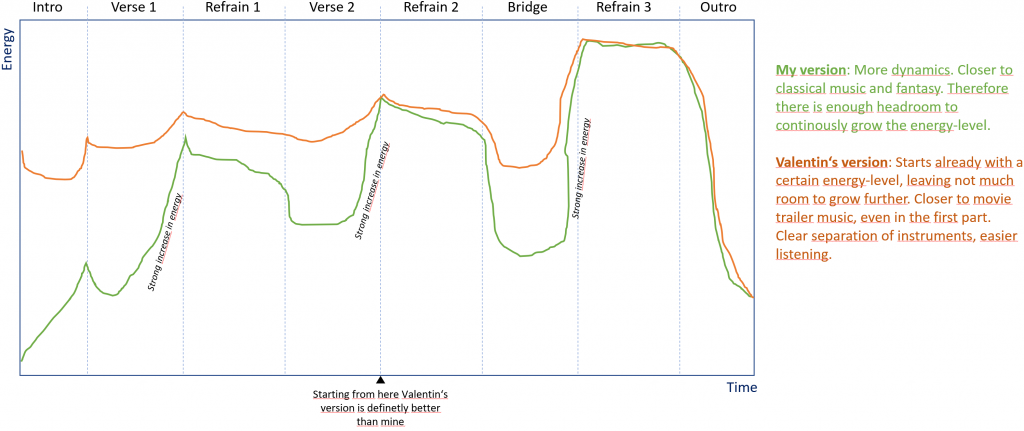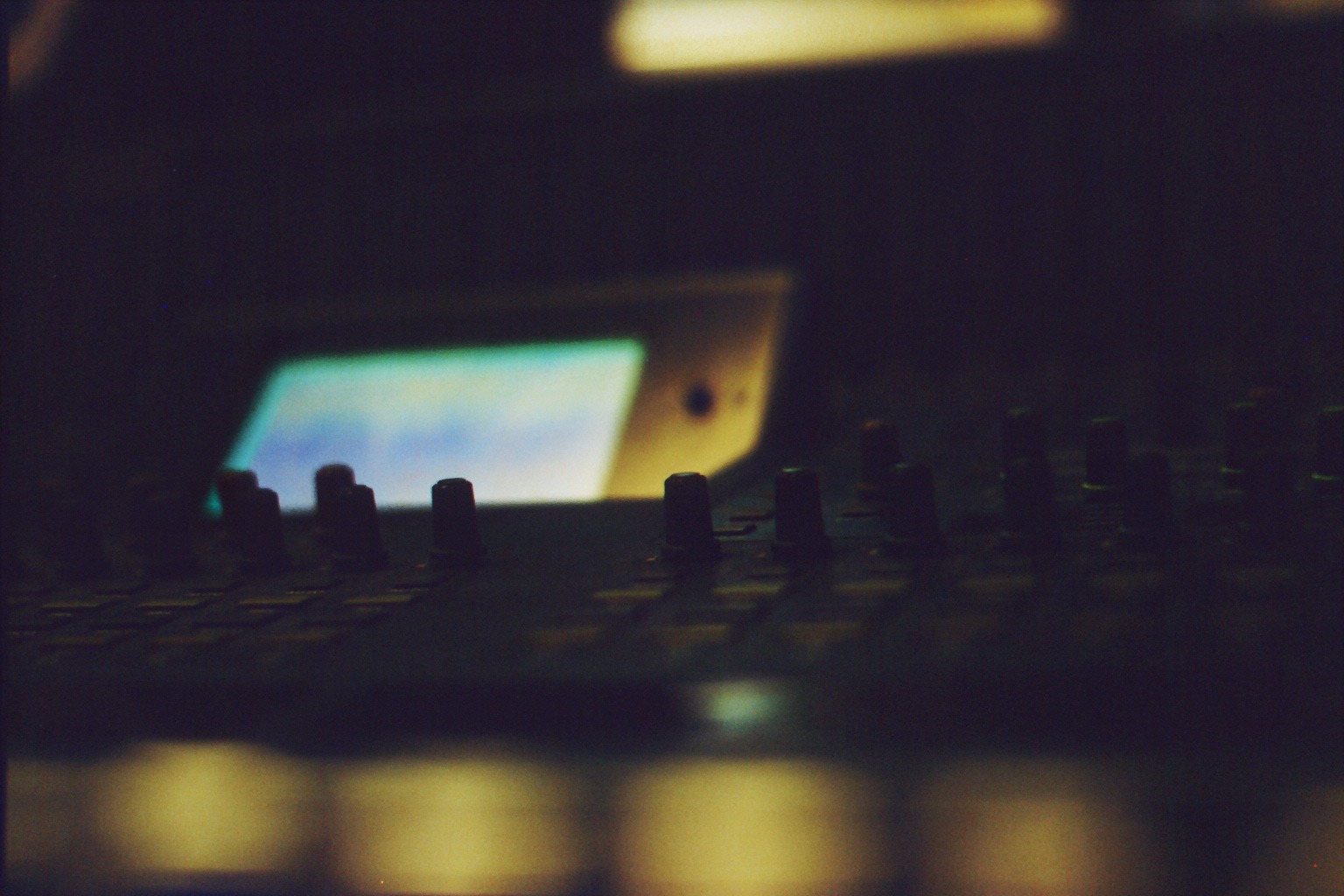In May 2022 my good friend Stalli and myself came up with the idea to create a song together. The actual output was not the primary focus – instead we wanted to learn as much as possible about how we could collaborate and create music end-2-end, including releasing it as a single. The good old learning-by-doing approach 🙂
After all we ended up with something completely different than originally planned.
The Plan
The original plan was that we would come up with a chord progression, and both of us would create various audio layers for this chord progression, which we would then stack on top of each other and mix together. It was inspired by the great project Music by 300 Strangers by Christian Henson. By doing this, we would learn how we could collaborate even though we are living in different cities.
We were aware of various tools for creative collaboration, amongst others Dropbox Replay and Frame.io. We wanted to use our project to evaluate those tools and check, whether they can really support the workflow.
Since neither of us ever has been working together with professional mixing engineers, we wanted to spend some money and try to find out how to use an online mixing studio to lift the quality of our track to a professional level.
In the end we would select an online distribution service such as Feiyr or iGroove and release the track on all major music streaming platforms. After all, nothing is more fulfilling than telling your friends “I have my song distributed at Spotify” 😉
This was the plan…
The Reality…
… with Collaborative Composing
The starting piece of the project was a chord progression with a simple melody. Since the main purpose of the project was to learn, the song structure was as simple as possible: A 4-chord-song in a pop song structure (Verse-Refrain-Verse-Refrain-Bridge-Refrain).
Both of us started to write the first layers of the song on our own in order to stack them on-top of each other. But soon we found out that it is not that easy: SinceI had written the song structure according to my standard workflow, I could simply continue by doing the next step (which was the orchestration in my case). But Stalli had much more problems with it – it was simply not “his song”.
After a month or so we realized, that whatever Stalli composed did simply not fit well. As if the song would reject all of his ideas. It took quite some time and courage to make the decision: Stalli would throw all his work away and start completely from scratch – with his own song structure. We did not plan any more to merge several audio layers from both of us and create one song. Instead we would create two songs, either one of us his own one.
Lesson learned: There are so many famous songwriter duos out there, but one should not forget that it is a very very rare and extraordinary constellation. Maybe the two of us have not (yet) the level of expertise to be able to collaborate in a musical context.
… with Dropbox Replay
We tried to use Dropbox Replay in the beginning. It seems to be really easy to use and gives the impression of a reliable and well-created tool, but after a while we realized that we switched back to the good old sending-files-via-Whatsapp-approach.
To be honest, I cannot tell why. Dropbox Replay would have been so much easier, especially when it comes to commenting certain regions of a track. Maybe because all the rest of the commnunication was done using Whatsapp. Maybe because humans are lazy. If we would be professional composers and had to pass deliveries back-and-forth while keeping deadlines, Dropbox Replay (or Frame.io) would be mandatory – in our hobby-context it was obviously not required.

Lesson learned: Dropbox Replay makes a great impression (so does Frame.io). Anyway, in our case we did not require it, but in professional contexts these tools might be a gamechanger.
… with the Mixing Studio
In the beginning we planned to use one of the many online mixing studios out there. Obviously to have a better end result, but also to learn what it needs to work with a mixing engineer. After some time we asked ourselfs why we ever decided that it needs to be an online mixing studio – we would learn and see much more if we would meet physically in a studio. Not only that we would have a really impressive time there, we would also directly interact with the mixing engineer, and we would be able to ask questions. Plus, at this point in time we already knew that both of our songs required recording of singers, and that it would be a great chance to learn how this is done as well.
We found a nice and cozy mixing studio close by which was perfect for us: Valentin (the owner) is a real nice person who never gave us the impression that we are noobs (which IS the case :D) but instead answered each of our questions. We asked him to do some kind of “training” session with us, more like a seminar than a regular mixing session. We booked two 4 hour sessions on two different days, so that we could recover a little (as non-professionals doing music for 4 hours straight is quite exhausting).
We asked my friend Lena and my sister Stephie whether they would sing for us and join us in the studio, and they agreed. Both of them did a great job, especially taking into account that they had almost no idea what they would have to sing that day. And for them it was the first time in a recording studio, too!

We learned a lot that day: Tons of steps in the mixing process, how recording is done and polished, how artifacts are being dealt with, and which tools and filters exist (Stalli spent quite some money throughout the next months on some of the plugins that Valentin was using). But also how to interact and communicate with a mixing engineer, what is important when you go into a studio, how to organize and exchange audio material, and much much more.
I was very enthusiastic when I came back home and instantly played the song to friends to show them how great the result is, but… it sounded really… bad! I did not understand – what had happened?
It took me some time to understand what was going on: Valentin told us when we left, that completing the songs would take ~1 week each. Thus the songs were in an unfinished state, having some things already improved but others still in the original or an intermediate state – an open heart. At that point in time we have heard the songs hundreds of times and could not really distinguish good from bad.
Additionally, the songs were also not mastered in any way, and now I listened to them on an audio setup of which I know that it is very sensitive to bad-mastered content.
But even worse: I always had a very clear picture of what my song should sound like, but I never actually told Valentin. I even was not able to present him a reference track although he asked for (after hours of searching I did not find much songs that had the same vibe as my song). Instead we went with “… ok, let’s choose some Hans Zimmer style…”.

Simply spoken: Valentin mixed the song in a direction that was not what I had in mind, and I did no even consider telling Valentin my concept. The whole process had to fail. And Valentin was not to blame – he did a great job.
Lesson learned: The mixing engineer needs to know what the actual conceptis, either by a reference track or by any other form of communication. Never give the engineer just the task to “improve it”, unless you have no idea yourself what you want and are okay with everything.
… with the Mastering
So, both Stalli and me went back to finish and mix our songs. Not only for weeks – we took another 5 months to do this. But finally we got to a stage where we considered them to be called “complete”.
Next question was, how to master them. My idea was to use the online mastering offer of the most famous studio in the whole world (Abbey Road) on the one side and do a simple self-mastering with iZotope Ozone 10 on the other side, and would then pick the better one.
I was very deeply impressed by what the assistant wizard of Ozone made out of my track – so much, that I thought to myself that it would be a waste of money to pay Abbey Road for mastering. Thus, I cancelled the idea and put the saved money into christmas presents :D.
Lesson NOT learned: I still do not know whether mastering in a studio is worth the money that it costs, in contrast to what Ozone and other “AI-supported” tools offer. This is something that I should find out in the future.
… with Song Distribution
Now we had our songs ready and mastered. The last step now was to give the songs to a distributor. We selected recordJet.com , which has a payment model that fits our we-try-something-out-and-do-not-want-to-continously-pay-anything approach.
Funny enough the music industry still thinks in Singles, EPs and LPs – even though I doubt that these formats make sense in a world of streaming providers any more. We were allowed to release our both (completely different) songs as one Single. We just had do provide the songs in the proper format and enter some meta data.
We chose an artist name for our little project: follow_the_matter. We also will setup a corresponding website, for a specific reason: Spotify has a realtime interface for the artists called Spotify for Artists, by which artists can get all kinds of realtime information about the listeners, enter information (such as tourdates, CVs, etc.) or add images and videos. In order to get access to it, as an artist you have to proove that you have access to the official email address of the artist, which is mentioned on the official artists homepage or social media accounts.
Lesson learned: Releasing songs with recordJet is comparably easy and did not have any unexpected limitations.
Summary
After more than half a year we finally considered the songs to be “finished”. We learned a lot, so much that it wouldn’t make sense to enlist here everything – the project was a great success, even though we threw the original concept overboard and created two distinct songs instead of one joint song.
I want to thank here everybody who was involved: Stalli for his great composing skills, his supportive work and the many times when he pushed me back on track. Lena and Stephie for their lovely singing and the trust they put in us when we asked them to go to a recording studio without telling them exactly what they had to sing there. My brother Korbi who could tell immediately, that the sound issues I was facing in my song were not the result of bad mixing but instead caused by bad songwriting in the composing phase. And Valentin, who agreed to do a (certainly exhausting) seminar on recording and mixing techniques, although people with our experience level are certainly not often in professional music studios.

